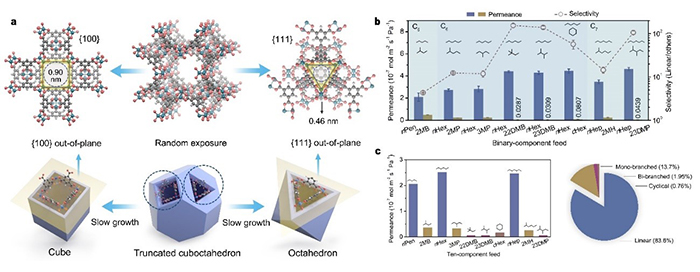In the petrochemical industry, light linear/branched alkane isomers (C5-C7) need to be effectively separated for different end uses, linear alkanes are to be cracked for ethylene production, whereas branched isomers are to be used for gasoline upgrading.
Recently, a research group led by Prof. YANG Weishen and Prof. BAN Yujie from the State Key Laboratory of Catalysis split linear alkanes from mono-branched and di-branched isomers as well as their cyclical counterparts through oriented metal-organic framework (MOF) membrane.
This study was published in Nature Communications on Oct. 19.
MOFs bring tremendous opportunities for membrane separation. HKUST-1 is an archetypal MOF with a combination of di-nuclear copper paddlewheel units and 1,3,5-benzenetricarboxylic acid to form a face-centered cubic network.
In this study, the researchers indicated that {111}-oriented HKUST-1 membranes were capable of splitting linear alkanes from branched isomers (or cyclical counterparts) by virtue of the size repulsion mechanism, since the rigid triangular pore with a size of ~0.46 nm running through {111} crystal facets was positioned between the kinetic diameters of alkane isomers.

The anisotropy of the porous HKUST-1 architecture and C5-C7 alkane isomer separation through {111}-oriented HKUST-1 membranes at 30°C (Image by BAN Yujie and WANG Yuecheng)
In this study, the {111}-oriented HKUST-1 membranes were formulated according to the morphology-biased principle and finally realized with a low dose synthesis method for terminating undesired crystal nucleation and growth. This membrane could realize one-step extraction of normal-pentane, normal-hexane and normal-heptane from a ten-component alkane isomer solution that mimicked light naphtha.
This work was supported by the National Natural Science Foundation of China and the Youth Innovation Promotion Association of CAS.